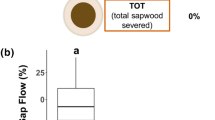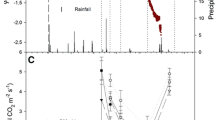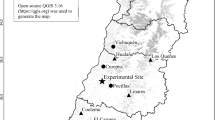Abstract
Forestry requires low mortality of transplanted seedlings. Mortality shortly after planting is often associated with inadequate hydration of transplants. Seedlings can be hardened to the drought conditions they may experience after transplanting by exposing them to controlled drought conditions in the nursery. Eucalyptus pilularis Sm. seedlings were drought hardened by providing nil (severe treatment) or half (mild treatment) the daily irrigation routinely received (control treatment) for up to two non-consecutive days per week during the last 4 weeks of growth in the nursery. Drought hardening reduced stem diameter, seedling leaf area, leaf area per root biomass and seedling quality measured by the Dickson quality index, but increased root:shoot ratio. Hardened seedlings had lower stomatal conductance and leaf water potential on the days they received less irrigation that the control treatment. Hardened seedlings had greater stomatal conductance and were less water stressed than seedlings experiencing drought for the first time indicating hardened seedlings had adjusted physiologically to drought. Survival after transplanting in the controlled drought environment in a glasshouse was enhanced by the hardening treatments. Non hardened seedlings that had had their upper leaves manually removed immediately prior to transplanting to reduce leaf area (top-clipped) had similar survival to hardened seedlings. Stomatal conductance and leaf water potential after transplanting were higher in hardened and top-clipped seedlings than unhardened control seedlings or vegetative cuttings. Survival in the field trial was over 95% for all treatments, possibly as rain fell within 4 days of planting and follow-up rain occurred in the subsequent weeks. Neither the hardened or top-clipped seedlings planted in the field trial had reduced growth, increased propensity to form double leaders or worse stem form than control seedlings when measured at age 3 years.



Similar content being viewed by others
References
Burdett AN (1990) Physiological processes in plantation establishment and development of specifications for forest planting stock. Can J For Res 20:415–427
Bureau of Meteorology (2009) Climate statistics for Australian locations. http://www.bom.gov.au/climate/
Campbell KA, Hawkins CDB (2004) Effect of seed source and nursery culture on paper birch (Betula papyrifera) uprooting resistance and field performance. For Ecol Manag 196:425–433
Chaudhry AK, Hafeez SM, Ghauri MJ (1995) Optimum watering level for Eucalyptus camaldulensis plants in the nursery stage. Pak J For 42:41–44
Close DC, Davidson NJ (2002) Revegetation to combat tree decline in the Midlands and Derwent valley lowlands of Tasmania: practices for improved plant establishment. Ecol Manag Restor 4:29–36
Close DC, Beadle CL, Brown PH (2005) The physiological basis of containerised tree seedling ‘transplant shock’: a review. Aust For 68:112–120
Dickson A, Leaf AL, Hosner JF (1960) Quality appraisal of white spruce and white pine seedling stock in nurseries. For Chron 36:10–13
Franco JA, Banon S, Fernandez JA, Leskovar DI (2001) Effect of nursery regimes and establishment irrigation on root development of Lotus creticus seedlings following transplanting. J Hort Sci Biotech 76:174–179
Grossnickle SC (2005) Importance of root growth in overcoming planting stress. New For 30:273–294
Guarnaschelli AB, Lemcoff JH, Prystupa P, Basci S (2003) Responses to drought preconditioning in Eucalyptus globulus Labill. Provenances. Trees 17:501–509
Jones HG (1992) Plants and microclimate: a qualitative approach to environmental plant physiology, 2nd edn. Cambridge University Press, Cambridge
Maillard P, Garriou D, Deleens E, Gross P, Guehl JM (2004) The effects of lifting on mobilisation and new assimilation of C and N during regrowth of transplanted Corsican pine seedlings. A dual 13C and 15N labelling approach. Ann For Sci 61:795–805
Mattsson A (1996) Predicting field performance using seedling quality assessment. New For 13:223–248
McGrath DA, Duryea ML (1994) Initial moisture stress, budbreak and two-year field performance of three morphological grades of slash pine seedlings. New For 8:335–350
Ngugi MR, Hunt MA, Doley D, Ryan P, Dart P (2003) Dry matter production and allocation in Eucalyptus cloeziana and Eucalyptus argophloia seedlings in response to soil water deficits. New For 26:187–200
Ojemakinde OA, Onwueme IC (1980) Heat and drought hardening of tomato (Lycopersicon esculentum) plants as an aid to field survival. Q J Int Agric 19:25–28
Reis GG, Hall AE (1986) Resistencia a desidratacao de Eucalyptus camaldulensis Dehn. com restricao do sistema radicular. Arvore 10:168–180
Rhizopoulou S, Davies WJ (1993) Leaf and growth dynamics in Eucalyptus globulus seedlings grown in dry soil. Trees 8:1–8
Rook DA (1973) Conditioning Radiata Pine seedlings to transplanting, by restricted watering. NZ J For Sci 3:54–69
Royo A, Gil L, Pardos JA (2001) Effect of water stress conditioning on morphology, physiology and field performance of Pinus halepensis Mill. seedlings. New For 21:127–140
Ruiz-Sanchez MC, Domingo R, Torrecillas A, Perez-Pastor A (1998) Water stress preconditioning to improve drought resistance in young apricot plants. Plant Sci 156:245–251
Sasse J, Sands R (1996) Comparative responses of cuttings and seedlings of Eucalyptus globulus to water stress. Tree Physiol 16:287–294
Searson MJ, Thomas DS, Montagu KD, Conroy JP (2004) Leaf water use efficiency differs between Eucalyptus seedlings from contrasting rainfall environments. Funct Plant Biol 31:441–450
Stape JL, Gonclaves JLM, Goncalves AN (2001) Relationships between nursery practices and field performance for Eucalyptus plantations in Brazil. New For 22:19–41
Thomas DS (2008) Hydrogel applied to the root plug of subtropical eucalypt seedlings halves transplant death following planting. For Ecol Manag 255:1305–1314
Thomas DS, Eamus D (1999) The influence of predawn leaf water potential on stomatal responses to atmospheric water content at constant Ci and on stem hydraulic conductance and foliar ABA concentrations. J Exp Bot 50:243–251
Thomas DS, Turner DW (1998) Leaf gas exchange of droughted and irrigated banana cv Williams (Musa spp.) growing in hot, arid conditions. J Hort Sci Biotech 73:419–429
Turner NC, Begg JE (1981) Plant-water relations and adaption to stress. Plant Soil 58:97–131
Villar-Salvador P, Planelles R, Oliet J, Penuelas-Rubira JL, Jacobs DF, Gonzales M (2004) Drought tolerance and transplanting performance of holm oak (Quercus ilex) seedlings after drought hardening in the nursery. Tree Physiol 24:1147–1155
Acknowledgments
This experiment was supported by the staff of Forests NSW Grafton Forest Nursery and Tree Improvement Nursery, and in particular appreciation is extended to Bevan Pugh, Kath French and Chris Moran for supplying seedlings and cutting, Geoff Heagney, Piers Harper and Darrel Johnstone for assistance in establishing the field and glasshouse experiments, and Michael Henson for statistical advice. Several reviewers provided insightful comments and their advice is greatly appreciated.
Author information
Authors and Affiliations
Corresponding author
Rights and permissions
About this article
Cite this article
Thomas, D.S. Survival and growth of drought hardened Eucalyptus pilularis Sm. seedlings and vegetative cuttings. New Forests 38, 245–259 (2009). https://doi.org/10.1007/s11056-009-9144-9
Received:
Accepted:
Published:
Issue Date:
DOI: https://doi.org/10.1007/s11056-009-9144-9




